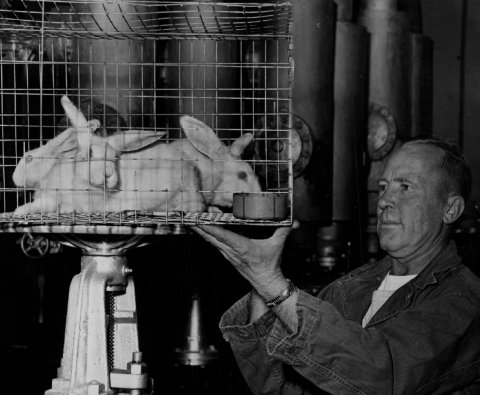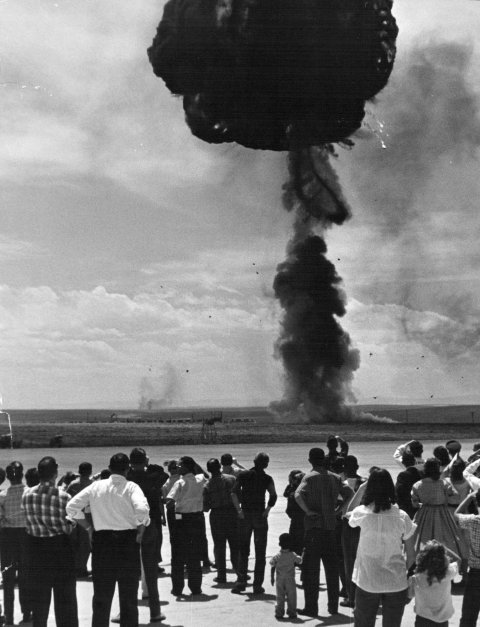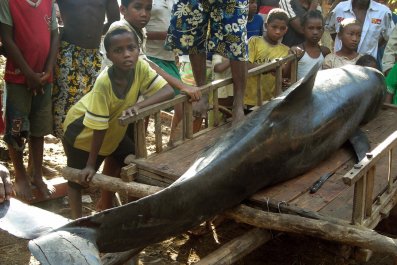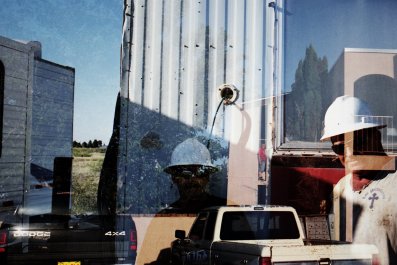Bison eye our car malevolently while red-tailed hawks circle overhead as we make our way through what was once the most toxic piece of land in the United States but is today a short-grass prairie dissolving green and blue into the horizon. Here, on the grounds of the Rocky Mountain Arsenal, the U.S. Army manufactured Sarin, the same lethal gas Syrian dictator Bashar Assad stands accused of using against his people.
I have come here to see the birthplace of American poison—and also its graveyard. The chemical agents and pesticides that were once made here have long been destroyed, the byproducts and tools of production buried beneath the Earth's surface. So, in that sense, the RMA is a tale of redemption—land returned to nature, wrested from man's darkest, most bellicose impulses.
But in a strange, ironic twist, I am one of very few people to stand on this pristine prairie on this seemingly perfect September day. Aside from my guides from the Environmental Protection Agency — which cleaned up RMA through its Superfund program — and the Fish and Wildlife Service, which runs it today as a wildlife refuge, there are no humans on this 27-square-mile public nature preserve.
That's because the Rocky Mountain Arsenal National Wildlife Refuge, as it is known today, is closed to visitors. Not because Sarin bombs have been unearthed, as they were in 2000. Nor because toxic chemicals like arsenic have seeped through the protective covers of the on-site landfills, a worry that surely crosses the minds of those who live in adjacent Commerce City, a working-class suburb of Denver.
Rather, the recent floods that ravaged Colorado broke a dam. As The Denver Post reported, a deluge that reached 15 feet in height led to the evacuation of a neighborhood next to the refuge that was home to a lot of "small horse properties." Officials from the Fish and Wildlife Service had aimed to reopen the refuge, which is 10 miles from Denver and the size of Manhattan, in early October, though the government shutdown has complicated those efforts. But I accept the lack of humans today as a small blessing: Coyotes skip through the grass, kestrels cut across the sky, prairie dogs pop up out of their holes, look suddenly busy, then disappear.
Of the many chemicals man has created in a lab, none is believed to be deadlier than Sarin, invented by German scientists on the cusp of World War II. Much of the United States's supply was concocted on what is, today, a prairie just north of Denver, an expanse of cottonwood groves splashed with yellow patches of cow daisies and bluish sage grass. You can see the city's skyline, but it seems distant, unreal. Only the roar of an occasional jet taking off from nearby Denver International Airport momentarily tugs you out of a frontier fantasy.
The land — once traversed by Plains Indians, then settled by homesteaders in the mid-19th century — was purchased by the Army right after the attack on Pearl Harbor, the site chosen because it was far from both coasts and thus not vulnerable to air attack; it was also well irrigated. And the area had many available workers—by 1945, a 3,100-strong workforce that was 50 percent women was manufacturing chemical agents like mustard gas (which had been used by Germany in World War I) and lewisite, an arsenic-based blister agent.
In addition, the Rocky Mountain Arsenal had a POW camp for German soldiers, called Rose Hill. Today, only the foundation of a watch post from Rose Hill is visible, and then only when pointed out by a ranger from the Fish and Wildlife Service. And just about all of the estimated 1,600 structures large and small that comprised RMA are gone — though a homestead from 1912 still stands, a reminder of the pioneers who first farmed this land. Lucille Egli McIntyre, to whose family the house belonged, supposedly still visits, though the fields of wheat and alfalfa her family harvested are long gone.
It was during the 1950s, as Cold War tensions grew, that the Army built a new facility that made the Rocky Mountain Arsenal "the free world's primary producer of Sarin during the 1950s," according to the EPA. The North Plants, as the new compound was called, spanned 90 acres and was composed of 103 buildings. One of these, known as Building 1501, served as a Sarin manufacturing plant from 1953 to 1957. The plant's central manufacturing building could withstand a nuclear attack, according to EPA remedial manager Greg Hargreaves, and an official Army history of the site says "[Sarin]-related operations were protected by elaborate alarm systems for leak detection." Elaborate, though, is a word open to disputation. An infamous photograph from the time shows a worker, covered entirely in protective gear, testing the Sarin plant for leaks by walking around with a rabbit in a cage.

According to Army records, the North Plants was used to also manufacture the nerve agent VX, as well as button bombs, which contained "red phosphorus, potassium chlorate and glass," along with micro-gravel mines loaded with "glass, lead oxide and RDX (cyclonite)." Also made at RMA was the napalm used during the Vietnam War; so was rocket fuel, including that for the Apollo 11 mission. At the same time, obsolete agents like mustard gas — and Sarin itself, in due time — were disposed of on the grounds of the Rocky Mountain Arsenal.
Starting in 1952, the Shell Chemical Company was allowed to use the site to manufacture many of the pernicious pesticides Rachel Carson decried in Silent Spring. Much of the waste from this activity went right into the ground, with little apparent concern about contamination of the air or groundwater. Carson, whose words galvanized the environmental movement, wrote of RMA: "Farmers several miles from the plant began to report unexplained sickness among livestock; they complained of extensive crop damage. Foliage turned yellow, plants failed to mature, and many crops were killed outright. There were reports of human illness, thought by some to be related." And that, she notes, was the case before Shell came to further sully the land.
As waste accrued from both the production and "demilitarization" of chemical agents, the Army sought creative solutions to disposing it. In 1962, the Army Corps of Engineers thought it a good idea to construct an injection well that would shoot the waste into a Precambrian rock bed 12,000 feet beneath the Earth's surface. This reportedly caused earthquakes in Denver, and the experiment was stopped. Nevertheless, the trenches and basins at the center of the arsenal, used both by the Army and Shell, became "the most toxic square mile on Earth," as EPA officials jokingly told me, repeating a popular local refrain. Though capped and monitored by the Army, this area, along with two other landfills in the northern section of the site, remain off-limits, and likely will be for many years to come.
Today, much of the world is demanding that Assad to destroy his Sarin stockpile — 189 countries have ratified the Chemical Weapons Convention, which prohibits the manufacture and stockpiling of chemical weapons; Syria, which just reportedly began destroying its own chemicals weapons, seeks to join that group. When the facilities at RMA were finally destroyed — including those for the manufacture of Sarin, mustard gas and other agents — they represented "the elimination of 60 percent of the United States's former chemical weapons manufacturing capacity," according to the EPA.
Once a Superfund site, the arsenal was declared a wildlife refuge in 1992, through an act of Congress that aimed "to conserve and enhance the land and water of the refuge in a manner that will conserve and enhance the natural diversity of fish, wildlife, plants and their habitats" — a touchingly hopeful mission for what had been the breeding (and dumping) ground for chemical weapons. President George H.W. Bush signed the Rocky Mountain Arsenal National Wildlife Refuge Act on October 9, 1992, six years after bald eagles had first been spotted on its grounds, in what for many had been a first sign of its redemption.
The path from chemical munitions to wildlife refuge was not a smooth one, with Shell and the Army paying some $2 billion to have the EPA scrub the site of the more than 600 chemicals identified there. That included treating groundwater, cleaning contaminated soil and making sure that the waste that would remain on-site did not seep out of its containment areas. Much of that work ended in 2003, when the EPA began removing land from its National Priorities List, the official name for Superfund.
However, challenges remain: In 2010, the EPA told Shell and the Army to test for 1,4-Dioxane, "an industrial chemical stabilizer that can migrate in groundwater." Hargreaves, the EPA manager, acknowledges that 1,4 1,4 Dioxane levels are "quite high," but says that there is no threat to nearby residents. Yet it seems like such warnings are likely to persist, as are such assurances. And to some, the all-too-recent memory of the 10 Sarin "bomblets" found — and safely discharged — in 2000 is probably enough reason to hold a picnic elsewhere. Charlie Scharmann, the Army's program manager for the site, insists that no dangers exist to the public anymore. In other words, this just may turn out to be a chemical weapons story with a happy ending.

It was the legacy of Sarin that had brought me to Colorado, but it was impossible to ignore an equally important story here—not that of man conquering nature in a lab, but that of nature overwhelming man. After all, the floods that swept across eastern Colorado last month have been called "biblical" for their force and destruction. And so, having seen the ravages of science, I went to see the ravages of nature.
Early the morning after my tour of the RMA, I drove north, out of Denver, into the industrial heart of Weld County. Another irony: Concoct poison gas, and you will eventually be rewarded with a wildlife preserve. But play host to 20,000 oil wells, as Weld County does, and you will be rewarded with a largely ruined landscape of steel storage tanks behind chain-link fences. The beauty of Colorado, so apparent at RMA, is only visible at a distance here.
According to an estimate in The New York Times, the recent flooding caused some 37,000 gallons of oil to spill, the paper noting that "the sight of drowning oil wells has inflamed the emotional debate over the West's new resource rush." Some believe the fears of spillage are overblown; Colorado Oil and Gas Association president Tisha Conoly Schuller deemed the spill "pretty small."Her group lobbies for the industry.
Then again, when I visited the small town of Evans, where, according to The Denver Post, oil stored by the Anadarko Petroleum Corp. had spilled into the South Platte River, a local resident — a contractor, it seemed — and police sergeant I spoke to were more concerned with overflowing sewage than leaking oil. Indeed, a putrid smell lingered in the cool morning air, likely the result of a waste-water treatment plant in town having been knocked out by the flood. The local, peering out from under the perfectly curved bill of his baseball cap, summarized the situation with the succinctness of a man of the plains: "Too much water, not enough time." The pudgy sergeant nodded in agreement.
The 10 Sarin "bomblets" found — and safely discharged — in 2000 is probably enough reason to hold a picnic elsewhere.
Time was acutely short in Boulder, too, right at the base of the Front Range of the Rockies. Though the South Platte River is normally a gentle stream, one perfect for an afternoon repose, during September's rains, it swelled and spilled over into the town. A waitress at a local restaurant — the kind of gluten-free joint that has become a signature of this yuppie mecca — Anna, 25, says wastewater flooded the house where she lived, destroying furniture. She will not return there, even if it is cleaned. "I've never seen anything like it in my life," says the Denver native. A digital map of Boulder that allows residents to chronicle damage serves as a community board of lamentation for homes ruined and property destroyed. Some of the dispatches are almost poetically evocative: "A large culvert failed and the road over it was destroyed."
It is even worse if you drive up into the Rockies, toward the hamlet of Jamestown. Many roads here are impassable. Along one, a crew worked next to a sign that said "We need dirt,"presumably to counter the vast erosive powers of the water that cascaded down these slopes. At one point, I left my car and descended into the bed of a creek, toward a destroyed bridge that looked as if it had been as easy to snap as a graham cracker. On the other side of the rocky bed were the remnants of a house, the seeming victim of a direct missile attack. Further ahead, the road to Jamestown was closed. Locals watched me struggle to turn my car around in the thick mud. "I hope that's a rental," one of them said dryly. It was.
Colorado is a paradoxical state, at once naturally pristine and thoroughly abused by man, with 18 Superfund sites to call its own. These include everything from the California Gulch mine high up in the Rockies to Rocky Flats, an Atomic Energy Commission site not far from RMA where plutonium triggers for nuclear weapons were manufactured.
One final irony: The rains that visited Colorado, and the "thousand-year" flood they caused, were very likely the result of human-caused global warming. We can expiate some of our sins by turning a Sarin-infested site into a wildlife refuge; but that's not quite enough. Says EPA official Rob Stites, looking over RMA's replenished grasslands, where prairie dogs burrow with unknowable purpose while egrets sit calmly on one of the reserve's lakes: "We think we can conquer nature. That's an absolute joke."




















